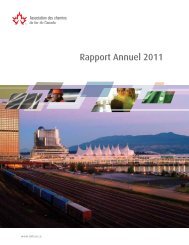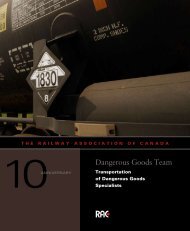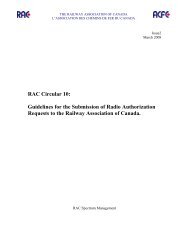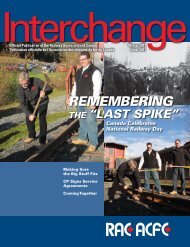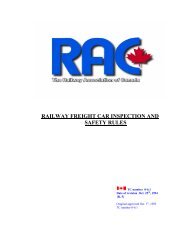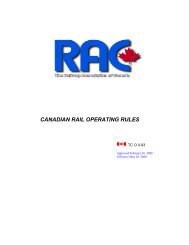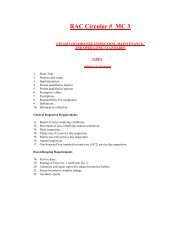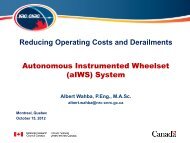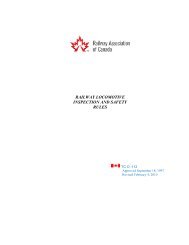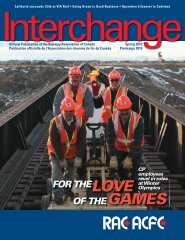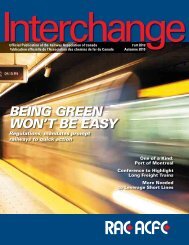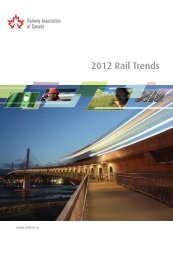Locomotive Emissions Monitoring Program - Railway Association of ...
Locomotive Emissions Monitoring Program - Railway Association of ...
Locomotive Emissions Monitoring Program - Railway Association of ...
You also want an ePaper? Increase the reach of your titles
YUMPU automatically turns print PDFs into web optimized ePapers that Google loves.
7 <strong>Emissions</strong> Reductions Initiatives<br />
The railways undertook various initiatives and deployed new technology in 2008 aimed at reducing locomotive diesel<br />
engine exhaust emissions, both overall and in terms <strong>of</strong> intensity per unit <strong>of</strong> work performed. Reductions can be<br />
achieved not only through improved diesel engine technology but also by introducing a variety <strong>of</strong> new rolling stock<br />
equipment designs, train handling improvements and infrastructure improvements that increase operational fluidity<br />
resulting in reduced fuel consumption and, hence, emissions. Section 7.1 describes the awareness generation actions<br />
<strong>of</strong> the RAC, while subsequent sections list the initiatives being pursued, or explored, by the railways or equipment<br />
supply companies regarding new technology, operating procedures, infrastructure enhancements and governmental<br />
funding support for actions to reduce fuel consumption and emissions.<br />
7.1<br />
RAC Awareness Generation Actions<br />
The RAC provides a venue for the railway companies to exchange ideas and best operating practices for reducing<br />
emissions associated with railway activities. The RAC represents virtually all <strong>of</strong> the railways operating in Canada.<br />
Its 54 members include Class I freight, Regional and Short Lines, Intercity Passenger, Commuter Rail and Tourist and<br />
Excursion railways.<br />
The RAC is in frequent communication with its members, through newsletters, E-mail distribution, working committees,<br />
RAC member events, the RAC Annual General Meeting and through the RAC website. For example, RAC coordinates the<br />
Canadian railway <strong>of</strong>ficer participation in annual meetings <strong>of</strong> fuel conservation teams wherein North American Class I<br />
railways share information on ‘best practice’ solutions, technologies and related information. As such, the RAC<br />
distributes relevant information within its membership regarding technologies and operating practices that reduce<br />
the emissions <strong>of</strong> GHGs on an activity basis.<br />
Furthermore, the RAC has an annual Environmental Award <strong>Program</strong> for both passenger and freight railways<br />
operating in Canada. The objective <strong>of</strong> the program is to share and assess initiatives undertaken by railways to<br />
improve their environmental performance. To date, this program has proven very useful in sharing various projects<br />
and initiatives within the RAC membership by recognizing, on a yearly basis, the efforts that individual railways<br />
have made in developing new environmental programs and initiatives. In 2008, recipients <strong>of</strong> the RAC Environmental<br />
Awards were CPR and VIA Rail Canada. 7<br />
In 2008, the RAC-developed on-line Rail Freight Greenhouse Gas (GHG) Calculator, a web-based user-friendly tool<br />
for calculating the GHG emissions associated with specific shipments was in active use 13 . This tool allows shippers<br />
and others to better understand, on a shipment by shipment basis, the difference in emissions levels by choosing<br />
the rail as compared to truck mode. As new data become available, the RAC updates the “input” factors employed to<br />
ensure it always reflects the particulars <strong>of</strong> the current transportation situation. The Calculator can be accessed at<br />
www.railcan.ca/site_ghg_calculator.<br />
7.2<br />
Equipment-related Initiatives<br />
7.2.1<br />
<strong>Locomotive</strong> Fleet Renewal<br />
Canadian freight and commuter railways are progressively renewing their fleets by acquiring new locomotives that<br />
are compliant with U.S. EPA emissions standards, the current on being the Tier 2 standard that came into force in<br />
2005. As <strong>of</strong> the end <strong>of</strong> 2008, 263 locomotives in the Canadian fleet meet this standard. Of the total, 236 are assigned<br />
to freight line-haul operations while 27 are in Commuter Rail services. Their diesel engines emit 62% less NOx than<br />
those in locomotives without emission control technologies. As these new locomotives also have higher-power and<br />
higher-adhesion capabilities, fewer locomotives are needed to pull the same train weight. This results in a more<br />
optimum matching <strong>of</strong> motive power to train operations, i.e., more time at high notch power levels, resulting in<br />
economies in fuel consumption and reduction in emissions intensities.<br />
Being examined for new yard and road switching locomotives are GenSet locomotives in which instead <strong>of</strong> a large<br />
medium-speed diesel engine the motive power is two or three smaller industrial Tier 3 diesel engines packaged as<br />
individual generator sets (hence the name ‘GenSets’). As each set turns itself on and <strong>of</strong>f electronically as needed,<br />
the result is in lower fuel consumption and emissions. Compared to a conventional Tier 0 switcher locomotive, the<br />
13 RAC Launches New Environmental Tool for Shippers, Press Release issued by the <strong>Railway</strong> <strong>Association</strong> <strong>of</strong> Canada, Ottawa, May 6, 2008<br />
27 LEM 2008





